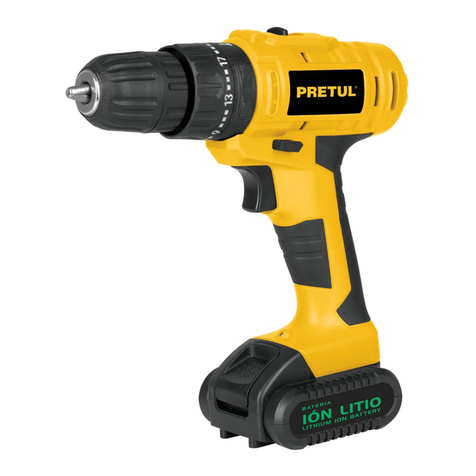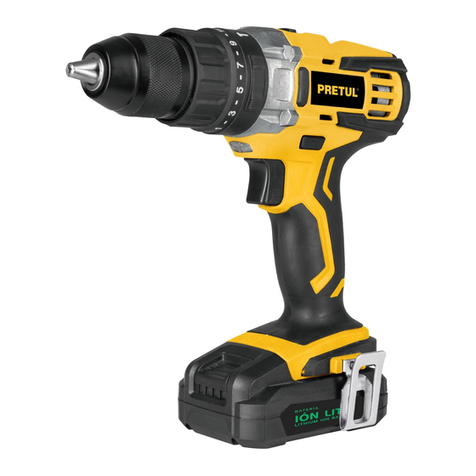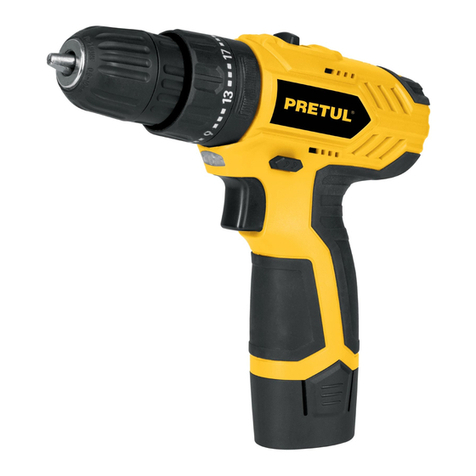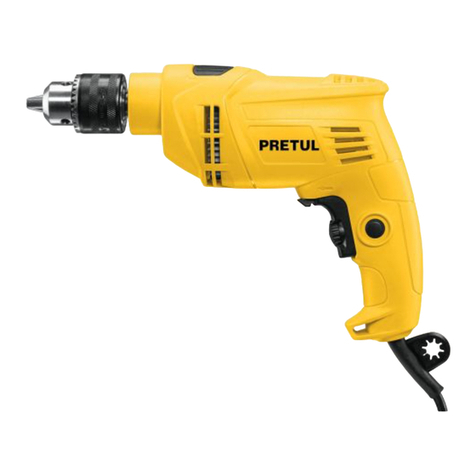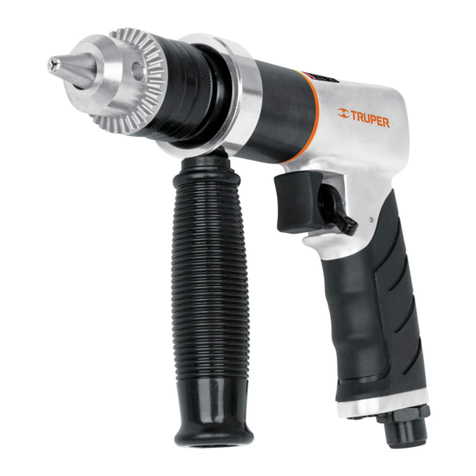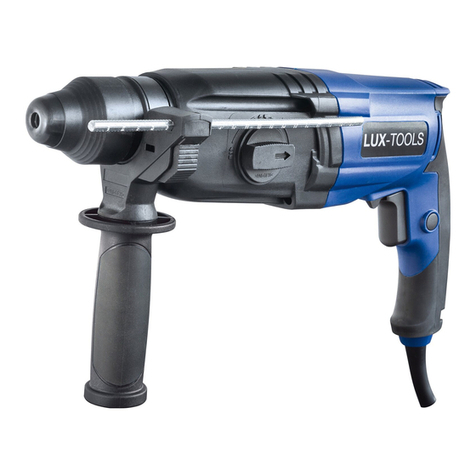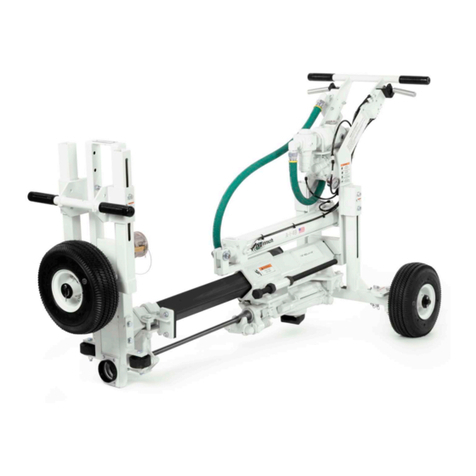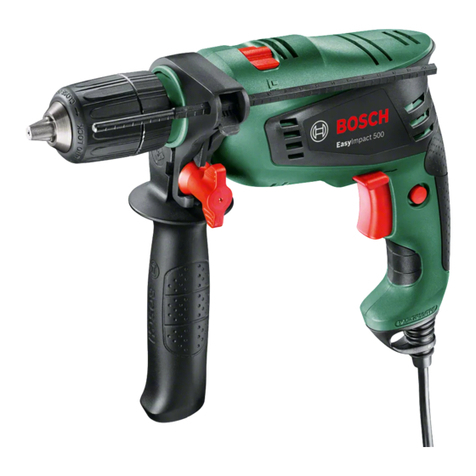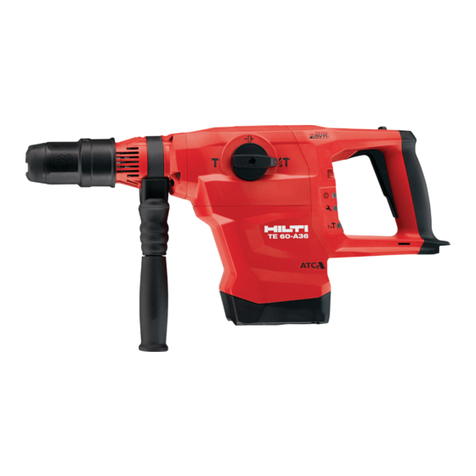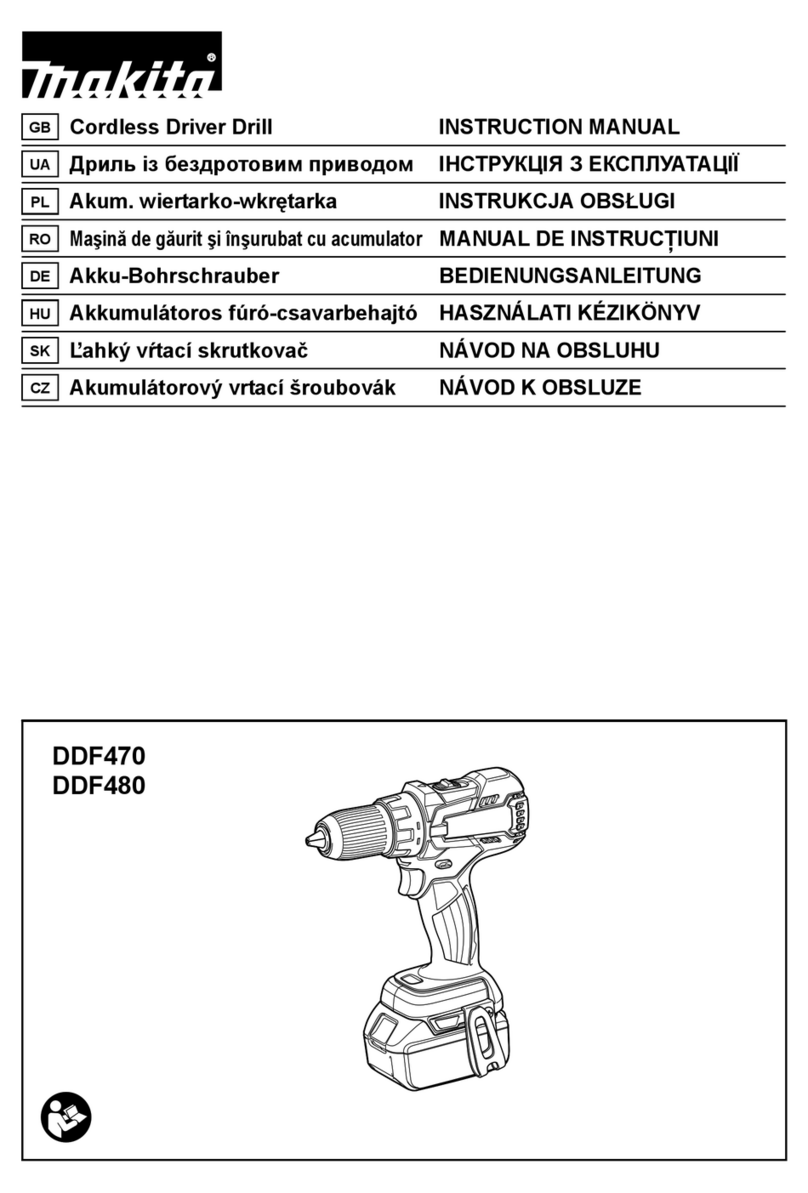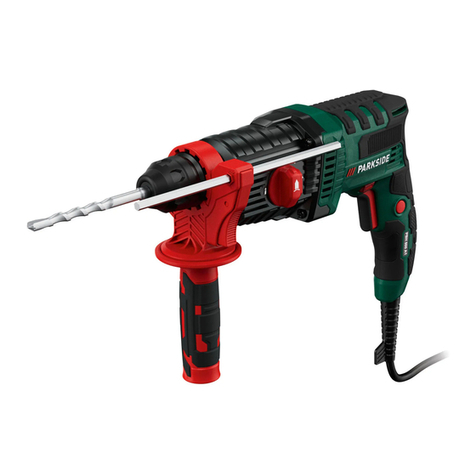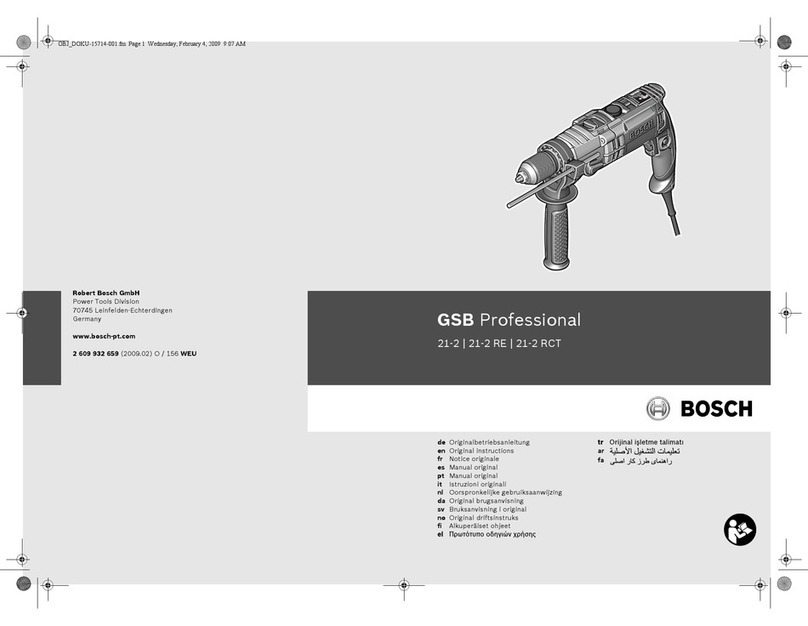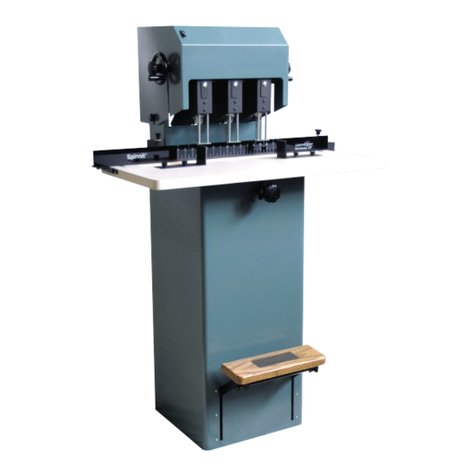PRETUL TALI-12P User manual

Modelo Código
TALI-12P
Este instructivo es para:
29975
ATENCIÓN Lea este Instructivo por completo
antes de usar la herramienta.
ESPAÑOL
ENGLISH
Instructivo de
Taladro / destornillador
inalámbrico
Broquero
12 V 9,5 mm
3/8”
TALI-12P

Í
ndice
2ESPAÑOL
Especificaciones técnicas
Requerimientos eléctricos
Advertencias generales de seguridad
para herramientas eléctricas
Advertencias de seguridad
para uso de taladros-destornilladores
Partes
Puesta en marcha
Solución de problemas
Mantenimiento
Protección ambiental
Centros de Servicio Autorizados
Sucursales
Póliza de Garantía
Guarde este Instructivo para futuras referencias.
Los gráficos de este Instructivo son para
referencia, pueden variar del aspecto real de la
herramienta.
3
3
4
5
6
6
9
9
9
10
12
12
TALI-12P
Para poder sacar el máximo
provecho de la herramienta,
alargar su vida útil, hacer válida
la garantía en caso de ser
necesario y evitar riesgos o
lesiones graves, es fundamental
leer este Instructivo por
completo antes de usar la
herramienta.
ATENCIÓN

3
Especificaciones técnicas
ESPAÑOL
TALI-12P
29975
3/8” (9,5 mm) sin llave
Clase II
0 - 600 r/min
Taladro / destornillador inalámbrico
madera: 19 mm | metal: 10 mm
adelante - reversa
15 + 1 función
Código
Descripción
Broquero
Tensión
Velocidad
Rotación
Torque
Capacidad de perforación
Batería
Aislamiento IP 20
Grado IP
Entrada: Tensión: 127 V
Frecuencia: 60 Hz
Potencia: 51 W
Cargador
El cable de alimentación tiene sujeta-cables tipo: Y
La clase de construcción del cargador es: Doble aislamiento.
12 V
Requerimientos eléctricos
Ión-litio 12 V 1,3 Ah | Tiempo de carga: 3.3 horas
Salida: 15 V 0,4 A
Si el cable de alimentación se daña, éste debe ser reemplazado por el fabricante o Centro de Servicio
Autorizado , con el fin de evitar algún riesgo de descarga o accidente considerable.
La construcción del aislamiento eléctrico de esta herramienta es alterado por salpicaduras o
derramamiento de líquidos durante su operación. No la exponga a la lluvia, líquidos y/o humedad.
Antes de obtener acceso a las terminales, todos los circuitos de alimentación deben ser desconectados.
ADVERTENCIA
ADVERTENCIA
de 0 A hasta 10 A
de 10 A hasta 13 A
de 13 A hasta 15 A
de 15 A hasta 20 A
18 AWG(*)
16 AWG
14 AWG
8 AWG
16 AWG
14 AWG
12 AWG
6 AWG
3 (uno a tierra)
de 1,8 m a 15 m | mayor de 15 m
Capacidad en
Amperes Número de
conductores Calibre de extensión
*Se permite utilizarlo siempre y cuando las extensiones mismas cuenten con un artefacto de protección contra sobrecorriente.
AWG = Calibre de alambre estadounidense (American Wire Gauge). Referencia: NMX-J-195-ANCE-2006
Al operar herramientas eléctricas en exteriores, utilice una extensión
aterrizada marcada como “Uso exterior” marca . Estas extensiones son
especiales para el uso en exteriores y reducen el riesgo de sufrir una descarga eléctrica.
ADVERTENCIA
Las herramientas de doble aislamiento y aislamiento reforzado
están equipadas con una clavija polarizada (una pata es más ancha que la otra). Esta
clavija cabe en cualquier enchufe polarizado y sólo puede conectarse de una forma. Si
la clavija no cabe en el enchufe, voltéelo. Si aún así no cabe, póngase en contacto con
un electricista calificado o instale un enchufe polarizado. No altere la clavija en forma
alguna. Ambos tipos de aislamiento eliminan la necesidad de un cable de corriente de
tres partes con conexión a tierra o de un sistema de corriente eléctrica con conexión a
tierra. Al usar un cable de extensión, asegúrese de usar el calibre suficiente para transportar la corriente que
consumirá su herramienta. Un cable de un calibre inferior ocasionará caídas de tensión en la línea, teniendo como resultado
pérdida de potencia y sobrecalentamiento del motor. La siguiente tabla muestra el tamaño correcto que debe usarse
dependiendo de la longitud del cable y de la capacidad de amperes indicada en la placa de datos de la herramienta. Si tiene
dudas use el siguiente calibre más alto.
ADVERTENCIA
ADVERTENCIA

4ESPAÑOL
Área de trabajo
Mantenga el área de trabajo limpia y bien iluminada.
Las áreas desordenadas y obscuras son propensas a accidentes.
No maneje la herramienta en ambientes explosivos, como en
presencia de líquido, gas o polvo inflamables.
Las herramientas eléctricas producen chispas que pueden encender
material inflamable.
Mantenga alejados a los niños y curiosos cuando opere la
herramienta.
Las distracciones pueden hacer que pierda el control.
Seguridad eléctrica
La clavija de la herramienta debe coincidir con el tomacorrien-
te. Nunca modifique una clavija. No use ningún tipo de
adaptador para clavijas de herramientas puestas a tierra.
Clavijas modificadas y enchufes diferentes aumentan el riesgo de
choque eléctrico.
Evite el contacto del cuerpo con superficies puestas a tierra
como tuberías, radiadores, cocinas eléctricas y refrigeradores.
Hay un mayor riesgo de choque eléctrico si el cuerpo está puesto a tierra.
No exponga la herramienta a la lluvia o condiciones de humedad.
El agua que ingresa en la herramienta aumenta el riesgo de choque eléctrico.
No fuerce el cable. Nunca use el cable para transportar,
levantar o desconectar la herramienta. Mantenga el cable
lejos del calor, aceite, orillas afiladas o piezas en movimiento.
Los cables dañados o enredados aumentan el riesgo de choque eléctrico.
Cuando maneje una herramienta en exteriores, use una
extensión especial para uso en exteriores.
El uso de una extensión adecuada para exteriores reduce el riesgo de choque
eléctrico.
Si el uso de la herramienta en un lugar húmedo es inevitable,
use una alimentación protegida por un interruptor de circuito
de falla a tierra (GFCI).
El uso de un GFCI reduce el riesgo de choque eléctrico.
Seguridad personal
Esté alerta, vigile lo que está haciendo y use el sentido común
cuando maneje una herramienta. No la use si está cansado o
bajo la influencia de drogas, alcohol o medicamentos.
Un momento de distracción mientras maneja la herramienta puede
causar un daño personal.
Use equipo de seguridad. Use siempre protección para los ojos.
El uso de equipo de seguridad como lentes de seguridad, mascarilla antipolvo,
zapatos antideslizantes, casco y protección para los oídos en condiciones
apropiadas, reduce de manera significativa los daños personales.
Evite arranques accidentales. Asegúrese de que el interruptor
está en posición “apagado” antes de conectar a la fuente de
alimentación y/o a la batería o transportar la herramienta.
Transportar herramientas eléctricas con el dedo sobre el interruptor o
conectar herramientas eléctricas que tienen el interruptor en posición de
“encendido” puede causar accidentes.
Retire cualquier llave o herramienta de ajuste antes de arrancar
la herramienta eléctrica.
Las llaves o herramientas que quedan en las partes rotativas de la
herramienta pueden causar un daño personal.
No sobrepase su campo de acción. Mantenga ambos pies bien
asentados sobre el suelo y conserve el equilibrio en todo
momento.
Esto permite un mejor control de la herramienta en situaciones inesperadas.
Vista adecuadamente. No vista ropa suelta o joyas. Mantenga
su pelo, su ropa y guantes alejados de las piezas en
movimiento.
La ropa o el pelo sueltos o las joyas pueden quedar atrapados en las piezas en
movimiento.
En caso de contar con dispositivos de extracción y recolección
de polvo conectados a la herramienta, verifique sus conexiones
y úselos correctamente.
El uso de estos dispositivos reduce los riesgos relacionados con el polvo.
Uso y cuidados de la herramienta
No fuerce la herramienta. Use la herramienta adecuada para el
trabajo a realizar.
La herramienta adecuada hace un trabajo mejor y más seguro cuando
se usa al ritmo para el que fue diseñada.
No use la herramienta si el interruptor no funciona.
Cualquier herramienta eléctrica que no pueda encenderse o
apagarse es peligrosa y debe repararse antes de ser operada.
Desconecte la herramienta de la fuente de alimentación
y/o de la batería antes de efectuar cualquier ajuste,
cambiar accesorios o almacenarla.
Estas medidas reducen el riesgo de arrancar la herramienta
accidentalmente.
Almacene las herramientas fuera del alcance de los niños y no
permita su manejo por personas no familiarizadas con las
herramientas o con las instrucciones.
Las herramientas eléctricas son peligrosas en manos no entrenadas.
Déle mantenimiento a la herramienta. Compruebe que las
partes móviles no estén desalineadas o trabadas, que no
haya piezas rotas u otras condiciones que puedan afectar su
operación. Repare cualquier daño antes de usar la herramienta.
Muchos accidentes son causados por el escaso mantenimiento de las
herramientas.
Mantenga los accesorios de corte afilados y limpios.
Los accesorios de corte en buenas condiciones son menos probables de
trabarse y más fáciles de controlar.
Use la herramienta, sus componentes y accesorios de acuerdo
con estas instrucciones y de la manera prevista para el tipo de
herramienta, en condiciones de trabajo adecuadas.
El uso de la herramienta para aplicaciones diferentes para las que
está diseñada podría causar una situación de peligro.
Advertencias generales de seguridad
para herramientas eléctricas
¡ADVERTENCIA! Lea detenidamente todas las advertencias de seguridad y todas las instrucciones que se
enlistan a continuación. La omisión de alguna de ellas puede dar como resultado un choque eléctrico, incendio y/o
daño serio. Conserve las advertencias y las instrucciones para futuras referencias.

5
ESPAÑOL
• Utilice únicamente el cargador incluido Pretul® para
cargar la batería de la herramienta. Usar otro cargador puede provocar un
incendio o riesgos de lesión.
• Use únicamente baterías diseñadas específicamente para la
herramienta. Otras baterías podrían generar riesgos de lesión o incendio.
• Conecte el cargador únicamente a un suministro de corriente alterna (c.a.).
• No use el cargador a la intemperie.
• Respete la polaridad “+/-” al cargar.
• Nunca recargue una batería que gotee.
• No use baterías o el cargador para propósitos distintos para los cuales fueron
diseñados.
• No modifique los contactos de la batería ni del cargador.
• Nunca exponga las baterías a temperaturas superiores a 50 °C
• Nunca exponga las baterías al fuego, podrían explotar.
• Las baterías deben mantenerse alejadas de cualquier
objeto metálico como clips, monedas, llaves, clavos, tornillos o cualquier otro
objeto que pudiera hacer que las terminales hagan contacto; pues provocaría
un cortocircuito que podría ocasionar quemaduras o incendios.
• Bajo condiciones extremas, el líquido de la batería
podría derramarse. De ser así, evite cualquier contacto. De ocurrir contacto
accidental, lave con agua abundante, enjuague con jugo de limón y vinagre. Si
el líquido entrara en contacto con los ojos, lave con agua abundante durante
varios minutos y busque ayuda médica de inmediato. El líquido expulsado de
las baterías podría causar irradiación o quemaduras.
• Para maximizar la vida útil de la batería descárguela por
completo por lo menos una vez al mes. No deje la batería sin recargar por
más de tres meses. Siempre cargue la batería a su máxima capacidad. Antes
de usar la máquina por primera vez, cargue la batería por un mínimo de 6
horas.
•Evite detenerse constantemente mientras taladra o atornilla, para evitar daños
a la batería.
Baterías y cargador
• Tómese su tiempo para evaluar el trabajo a realizar y asegúrese de haber
respetado todas las precauciones necesarias antes de comenzar a taladrar.
• Ajuste correctamente la broca al broquero.
• Antes de perforar en una pared, suelo o techo, asegúrese
de que no haya objetos empotrados, tales como cables o conducciones
eléctricas o tuberías.
• Asegúrese que el interruptor esté apagado (posición OFF)
antes de insertar la batería, de lo contrario ésta comenzará a funcionar
inesperadamente, pudiendo provocar lesiones graves.
• Apague y desconecte la herramienta antes de invertir el
sentido del giro del broquero, así como de instalar o reemplazar una broca.
Antes de operar la herramienta
• Sostenga la herramienta por las superficies aisladas diseñadas para este
propósito, sobre todo al realizar trabajos en los que la broca pueda hacer
contacto con cableados ocultos. El contacto con un cable conductor de
corriente hace que las piezas metálicas de la herramienta también tengan
corriente y den una descarga al operador.
• Utilizar las manijas auxiliares, si se proporcionan con la herramienta. La
pérdida de control puede causar lesiones personales.
• No someta la herramienta a esfuerzos excesivos.
• Si la broca se atasca en la pieza de trabajo, apague la
herramienta de inmediato. Luego retire la broca de la pieza de trabajo. No
intente retirar las brocas atoradas encendiendo y apagando la herramienta.
• No ejerza demasiada presión a la herramienta con tal de acelerar la
perforación. De lo contrario la broca se dañaría y la eficiencia de la
herramienta disminuiría al igual que su vida útil.
• En cuanto más grande sea el diámetro de la
broca, la fuerza reactiva es mayor, lo que puede provocar una pérdida del
control de la herramienta. Para evitar esta posibilidad sujete firmemente la
herramienta con ambas manos y mantenga una posición equilibrada sobre
ambos pies mientras perfora a 90°
• Esté atento y preparado para relajar la fuerza en cuanto la broca atraviese el
material. Los movimientos repentinos pueden romper la broca o dañar el
cuerpo de la herramienta.
• No toque la broca ni las perforaciones inmediatamente
después de taladrar. Espere a que se enfríen para manipularlas. No intente
enfriarlas con agua o aceite.
• Antes de soltar la herramienta, asegúrese de que todas las partes móviles
se hayan detenido por completo.
• Evite colocar la herramienta en un sitio con partículas y/o polvo
inmediatamente después de haber sido usada, estas pueden ser absorbidas
dentro del mecanismo de la herramienta y así dañarla.
• Utilice protectores auriculares, cuando ejecute
servicios que hagan ruidos superiores a 85 dB
• Utilice mascarilla antipolvo y un equipo extractor de polvo si
es necesario. Recuerde que trabajar materiales como asbesto,
pinturas con plomo, aditivos, algunos tipos de madera, metales
o minerales es altamente tóxico.
• Utilice gafas de seguridad.
Mientras opera la herramienta
• Elija la broca apropiada para el material a trabajar, esto
reduce el riesgo de lesiones graves y agiliza el trabajo.
• Para metal o plástico use brocas para trabajos en metal. Las medidas
abarcan un mínimo de 0,8 mm hasta la capacidad máxima del broquero.
• Para madera use brocas ordinarias para trabajos de madera. En cualquier
caso, perforando orificios de 6,5 mm o menos, use brocas para trabajos en
metal.
• No intente utilizar brocas que excedan la capacidad del broquero.
Elija la broca apropiada
Uso y cuidado de la herramienta a baterías
Recargue sólo con el cargador especificado por .
El cargador indicado para una batería puede ocasionar peligro de incendio si
se utiliza con otra batería.
Use baterías específicamente diseñadas para la herramienta.
El uso de cualquier otra batería puede ocasionar peligro de daños e incendio.
Cuando la batería no esté en uso, manténgala alejado de
cualquier objeto metálico como clips, monedas, llaves, clavos,
tornillos o cualquier objeto metálico que pueda hacer conexión
entre las terminales.
Un cortocircuito entre las terminales puede ocasionar quemaduras o incendio.
En condiciones severas, puede derramarse líquido de la batería;
evite el contacto. Si hay contacto accidental, lave la zona con
agua. Si hay contacto con los ojos, busque ayuda médica.
El líquido derramado puede causar irritación o quemaduras.
Servicio
Repare la herramienta en un Centro de Servicio Autorizado
usando sólo piezas de repuesto idénticas.
Para mantener la seguridad de la herramienta.
Advertencias de Seguridad
para uso de taladros-destornilladores
ATENCIÓN
ATENCIÓN
ATENCIÓN
ATENCIÓN
ATENCIÓN
ATENCIÓN
ATENCIÓN
ADVERTENCIA
PELIGRO
PELIGRO
PELIGRO
PELIGRO
PELIGRO
PELIGRO
Esta herramienta cumple
con la Norma Oficial
Mexicana (NOM).

6ESPAÑOL
1
2
Partes
Puesta en marcha
Mango
Conexión
del cargador
Botón de dirección
de giro y bloqueo
del interruptor
Luz
LED
Interruptor
Botón de
liberación
de batería
Batería de ión litio
(incluye una batería)
Batería de ión litio
(incluye una batería)
Regulador
de torque
Broquero
sin llave
Cargador
de batería
Orificio para la
conexión del cargador
1. Conecte la clavija del cargador en un
tomacorriente de 127 V~
2. Inserte la conexión del cargador en el orificio de
la batería. La luz roja deberá encenderse, indicando
que la carga se ha iniciado.
• Cuando la batería se encuentre completamente
cargada, la luz verde se encenderá y la roja se
apagará.
• Desconecte el cargador del tomacorriente una vez
concluida la carga.
• Si la luz roja parpadea es señal de que la batería
está defectuosa, reemplácela por una nueva.
• Si la luz verde parpadea es señal de que la
temperatura de la batería es menor a 0 °C o mayor
a 45 °C. Espere a que la temperatura de la batería
se encuentre en el rango adecuado para poder
cargarla.
Carga de la batería
Indicador de nivel
de batería

7
ESPAÑOL
Puesta en marcha
La batería viene DESCARGADA de fábrica. Será necesario que la cargue por aproximadamente 6 horas antes de poder usarla.
La temperatura normal de carga es de 0 °C a 45 °C. Fuera de este rango se suspende la carga automáticamente hasta que alcance
la temperatura correcta. La temperatura normal de descarga / trabajo es de 0 °C a 75 °C. Si los 75 °C se exceden, el control
electrónico apaga la energía de la herramienta hasta que la temperatura alcance de nuevo el rango óptimo de temperatura.
Cuando la batería tenga bajo nivel de tensión durante el trabajo, la herramienta deja de funcionar.
Entre cada carga, dé al cargador 15 minutos de descanso. En un ambiente cálido o después de uso prolongado, es posible
que la batería se caliente demasiado como para ser recargada. Permita que la batería se enfríe antes de intentar recargarla.
Consideraciones para el uso de la batería
• Sujete la base del broquero firmemente con una mano y
con la otra, afloje la punta del broquero, girándola en
sentido contrario a las manecillas del reloj.
• Inserte la broca hasta el tope o retírela según sea el caso.
• Gire la punta del broquero en sentido de las manecillas
del reloj para asegurar la broca.
Instalación de brocas o adaptadores
• Para perforar y atornillar, suelte el interruptor y presione el botón de
dirección de giro del lado en donde las marcas apuntan hacia el broquero.
• Para invertir el sentido y desatornillar, presiónelo del lado contrario.
La primera vez que encienda el taladro después de
invertir la rotación, puede escucharse un clic. Esto es normal y no
representa ningún problema.
Nunca invierta la dirección de la rotación mientras el
taladro se encuentre en funcionamiento, para no dañar la herramienta.
Dirección de rotación
Ajuste de torque
ATENCIÓN
ATENCIÓN
Punta del
broquero
Adelante Reversa
Base del
broquero
Regulador
de torque
• Para seleccionar el nivel de torque deseado gire el regulador de torque
hasta hacer coincidir el número correspondiente con la marca superior:
de 1 a 4 para tornillos pequeños,
de 5 a 9 para tornillos en material suave,
de 10 a 15 para tornillos en material suave y duro.
• Para perforar metal, madera o plástico, gire el regulador de torque a la
posición de TALADRO ( coincidiendo con la marca superior).
El nivel de torque necesario depende del tipo de
tornillo a usar y del material sobre el cual se trabaje. Si tiene duda use
un menor torque e increméntelo gradualmente hasta lograr el
adecuado. Un torque adecuado evita daños a la herramienta.
ATENCIÓN

8ESPAÑOL
Puesta en marcha
Encendido y control de operación
• El interruptor le permite seleccionar la velocidad adecuada
para cada tarea. Mientras más apriete el interruptor, más
rápido operará el taladro.
Atornillar - desatornillar
• Se recomienda que primero se perfore un “orificio
piloto”, ligeramente más largo y apenas más angosto de lo
que mide el tornillo a insertar. El orificio piloto actuará
como guía para la entrada del tornillo, al tiempo que
facilitará apretarlo. Cuando un tornillo es colocado cerca
del borde de una pieza, un orificio piloto también ayudara
a prevenir que la madera se parta.
• Use el tipo de punta adecuado para cada cabeza de
tornillo, para evitar que el tornillo sobresalga de la superficie.
• Si se dificultara la inserción de un tornillo, remuévalo e
intente perforar un orificio ligeramente más largo o ancho.
Sin embargo, recuerde que debe haber suficiente material
para que el tornillo se sujete. Si reinicia la operación de
atornillado en un orificio ya hecho, empiece enroscándolo
a mano. Si aún así fuera difícil de enroscar (como sería el
caso con maderas muy duras), intente usar un lubricante
como jabón; el jabón líquido tiende a ser el más útil.
• Siempre aplique suficiente presión sobre el taladro para
evitar que la cabeza se barra. Es fácil que la cabeza del
tornillo se dañe, lo que dificultará insertarlo por completo
o incluso removerlo.
Recomendaciones adicionales
• Use la velocidad adecuada a cada tarea: no trate de
perforar a velocidades bajas ni de atornillar a altas
velocidades.
• Si la operación sobrecarga el taladro, extráigalo y repita la
operación aplicando menos fuerza.
• Use bajas velocidades para iniciar perforaciones donde
no hay punto de apoyo, sobre plástico o metal, al
atornillar, al perforar cerámica o cualquier aplicación que
requiera de torque elevado. Utilice altas velocidades para
taladrar madera y al usar artículos para pulir.
•Para obtener el máximo de vida de su taladro, use el
control de velocidad variable.
Taladrar
• Cuando trate de perforar orificios de diámetros grandes,
siempre es mejor iniciarlos con una broca delgada y
después cambiarla por una del tamaño requerido. Esto
previene la sobrecarga del taladro.
• Al taladrar orificios profundos retire la broca sólo un poco
y con regularidad mientras perfora, para que la viruta
pueda ser expulsada adecuadamente del orificio.
• Si la broca se atasca, suelte el
interruptor inmediatamente para prevenir daños
permanentes en la herramienta. Intente desatascar la broca
invirtiendo el sentido de operación.
•Mantenga el taladro alineado con respecto al orificio.
Idealmente, la broca deberá entrar siempre perpendicular-
mente en la pieza de trabajo. Si el ángulo es cambiado
durante el proceso de perforado, esto podría hacer que la
broca se rompiera, bloqueando el orificio o incluso
causando lesiones personales.
ATENCIÓN
La luz LED se enciende
mientras el interruptor sea
apretado y se apaga cuando
se suelta el interruptor.

9
Solución de problemas
ESPAÑOL
Mantenimiento
• Mantenga las ventilas limpias y libres de obstrucciones
para garantizar un enfriamiento adecuado del motor.
• Inspeccione regularmente todos los tornillos de montaje
y asegúrese de que estén apretados correctamente. En
caso de que alguno de los tornillos esté suelto, apriételo
inmediatamente.
• Use un paño limpio y suave para limpiar la herramienta.
Nunca use alcohol o detergente. Desconecte la
herramienta y remueva la batería antes de limpiarla.
El servicio de las herramientas debe ser realizado
únicamente en un Centro de Servicio Autorizado
. El servicio y mantenimiento realizado
por personas no calificadas puede resultar peligroso y
llegar a ocasionar daños personales además de invalidar la
garantía del producto.
Limpieza y cuidados Servicio
El taladro pierde
eficacia.
El gatillo no se puede
apretar.
El gatillo puede
apretarse pero el
broquero no gira.
El regulador de
torque impide la
operación.
La batería gotea.
La batería no se carga
y la luz indicadora de
nivel de carga no se
enciende.
El taladro se calienta
después de periodos
de trabajo
prolongados.
La batería se calienta
durante la operación.
La batería se calienta
durante la carga.
El cargador se calienta
durante la carga.
• Cargue la batería.
• Mueva el botón de dirección de giro a la
posición de giro o reversa.
• Cargue la batería.
• Ajuste el regulador a un torque que permita el
trabajo. Pruebe con el siguiente nivel de torque.
• Limpie de inmediato con agua y jabón el
líquido de la piel o ropa.
• Reemplace la batería de inmediato.
• Inserte correctamente la conexión del cargador
a la batería.
• Revise que la clavija del cargador se encuentre
bien conectada al tomacorriente.
• Permita que el taladro se enfríe por espacio de
5 minutos.
• Detenga el taladro por espacio de 5 minutos
para que la batería se enfríe.
Problema Solución
• Batería baja.
• El botón de dirección de giro se encuentra en
la posición de bloqueo.
• Batería descargada.
• El regulador está ajustado en un torque
inadecuado.
• Goteo diminuto podría presentarse en
temperaturas extremas o después de un uso
pesado, esto es normal.
• El goteo intenso o muy evidente es debido a
una batería dañada.
• Conexión del cargador mal instalada en la
batería.
• Cargador mal conectado al tomacorriente.
• Este calentamiento es normal, ya que absorbe
la energía que los engranes del motor y la
electricidad generan durante el trabajo.
• Este calentamiento es normal, la energía que
se extrae de la batería mientras el taladro está
en marcha hace que ésta se caliente.
• Este calentamiento es normal, resultado de las
reacciones químicas que suceden dentro de la
batería mientras se carga.
• Este calentamiento es normal, resultado de la
regulación de tensión.
Causa
Protección ambiental
Los aparatos eléctricos y las baterías no deben desecharse junto con los desperdicios domésticos. Por favor, entregue
este aparato, así como sus baterías con los contactos aislados con tela adhesiva a un centro de reciclaje. Verifique la
ubicación del centro más cercano a su comunidad.

Centros de Servicio Autorizados
10
En caso de tener algún problema para contactar un Centro de Servicio consulte nuestra página www.truper.com
donde obtendrá un listado actualizado, o llame al teléfono: 01(800) 690-6990 ó 01(800) 018-7873 donde le
informarán cuál es el Centro de Servicio Autorizado más cercano.
AGUASCALIENTES
BAJA
CALIFORNIA SUR
CHIHUAHUA
COAHUILA
COLIMA
CHIAPAS
CIUDAD DE
MÉXICO
DURANGO
ESTADO DE
MÉXICO
GUANAJUATO
GUERRERO
HIDALGO
671615 SUPER TOOLS
ZARAGOZA NO. 1205, COL. EL SOL, AGUASCALIENTES,
AGS. TEL.: 01(449) 996-5978
670796 CONTRURENTAS
PROL. I. ZARAGOZA Y MÁRQUEZ DE LEÓN,
COL. 5 DE FEBRERO, SAN JOSÉ DEL CABO, BCS
TEL.: 01(624) 142-4595
670032 PROVIND
AV. COLEGIO MILITAR No. 4307 A, COL. NOMBRE DE
DIOS C.P. 31100, CHIHUAHUA, CHIH. TEL.: 01(614)
424-4000
671530 FERRETERÍA AMAYA S.A. DE C.V.
AV. ORTIZ MENA No. 81, COL. CENTRO C.P. 33800
PARRAL, CHIH. TEL.: 01(627) 522-2600
670712 INDUSTRIAL FERRETERA DE MONCLOVA,
S.A. DE C.V. BLVD. HAROLD R. PAPE No. 1000, COL.
CENTRO C.P. 25700 MONCLOVA, COAH.
TEL.: 01(866) 632-0174 FAX: 01(866) 633-0719
671742 SURTIDORA DE FERRETERÍA AV. ANTONIO
LEAÑO ÁLVAREZ No. 527 COL. PONCIANO ARRIAGA.
TECOMÁN, TEL.: 01(313) 324-2000 y 7666 FAX: 325-2700
671770 TORNILLOS Y HERRAMIENTAS PINEDA 17
PONIENTE No. 20-A, COL. CENTRO TAPACHULA, CHIAPAS
TEL.: 01(962) 626-2807
671709 FERRETERA MANDIOLA, S.A. DE C.V. 5a
NORTE PONIENTE No. 1615-B, COL. MOCTEZUMA,
C.P. 29000, TUXTLA GUTIÉRREZ, TEL.: 01(961) 602-1544
671747 CENTRO DE SERVICIO DEL SURESTE
LIBRAMIENTO SUR ORIENTE S/N km 6.5
COL. TRABAJADORES, TUXTLA GUTIÉRREZ, CHIAPAS
TEL.: 01(961) 223-2350
670515 FERRETERÍA CASUA
RAMÓN CORONA No. 72, COL. BARRIO SANTA LUCÍA C.P.
29250, SAN CRISTOBAL DE LAS CASAS, CHIS.
TEL.: 01(967) 678-6283
671601 MATERIALES DE CONSTRUCCIÓN DE LOS
ALTOS, S.A. DE C.V. FRANCISCO I. MADERO No.5, COL.
CENTRO, C.P. 29200, SAN CRISTOBAL DE LAS CASAS,
CHIS.
671730 MATERIALES Y ACEROS BALAM S.A.
PERIFERICO NORTE-PONIENTE No. 50 COL. BISMAR, SN.
CRISTOBAL DE LAS CASAS TEL.: 01 (967) 678-6162 y 7422
670781 PREFABRICADOS DE PALENQUE, S.A. DE C.V.
km 1 CARRETERA PALENQUE - PAKAL-NÁ S/N ENTRADA
LIENZO CHARRO C.P. 22960, PALENQUE, CHIS. TEL.: 01
(916) 345-1523 | 345-1533
671829 EL FUERTE DE LAS HERRAMIENTAS S.A. DE
C.V. PONIENTE 140 No.618 LOCAL B, COL. INDUSTRIAL
VALLEJO, AZCAPOTZALCO, C.P. 02300 TELS.: 01(55)
5587-7959 y 7731
670995 EL MONSTRUO DE CORREGIDORA S.A. DE
C.V. CORREGIDORA No.22, COL. CENTRO C.P. 06060
CIUDAD DE MÉXICO TEL.: 01(55) 5522-4861 | 71 y
01(55) 5522-5031, FAX: 01(55) 5522-5021
671370 ADMINISTRADORA FERRETERA, S.A. DE C.V.
CORREGIDORA No. 76-A, COL. CENTRO C.P. 06060
CIUDAD DE MÉXICO TEL.: 01 (55) 5522-9976
FAX: 01(55) 5522-9966
671131 CERRADA PINO SUAREZ No. 24, COL. ZONA
ESCOLAR C.P. 07230, GUSTAVO A. MADERO, CIUDAD DE
MÉXICO TEL.: 01(55) 2207-0882
671137 INGENIERÍA SUMINISTROS Y SERVICIOS
INDUSTRIALES CALZADA DE GUADALUPE No.525-A,
COL. ESTRELLA, C.P. 07810, GUSTAVO A. MADERO,
CIUDAD DE MÉXICO TEL. Y FAX: 01(55) 5577-9331 |
5781-7079
670350 TORNILLOS ÁGUILA, S.A. DE C.V.
MASURIO No. 200 ESQUINA GALIO, COL. LUIS
ECHEVERRIA C.P. 34250, DURANGO, DGO.
TEL.: 01(618) 817-1946 | 818-2655
671671
ENRIQUE CARROLA ANTUNA NO. 406 COL. CIÉNEGA,
DURANGO, DGO. TEL.: 01(618) 825-2710
671600 ABC DE MATERIALES, S.A. DE C.V.
VENUSTIANO CARRANZA No. 104 COL. LOS ÁNGELES
TOTOLCINGO, ACOLMAN, EDO. DE MÉXICO
TEL.: 01(55) 2958-8504
671723 FERRETERA TECAMAC S.A. DE C.V.
CARR. MEXICO-PACHUCA km 37.5 TECAMAC, EDO. DE
MÉXICO. TEL.: 5934-6396 Y 5934-6271
671765 TLAPALERIA CRUZ
AV. CUAUHTEMOC No. 3 COL. BO. SAN JOSÉ,
TEQUIXQUIAC, TEL.: 591-91-203-44
671025 SERVICIO Y VENTA DE HERRAMIENTAS VG
AV. DE LOS MAESTROS No. 14, COL. LEANDRO VALLE
C.P.54040, TLANEPANTLA DE BAZ, EDO. DE MÉXICO, TEL.:
01(55) 2628-3120 Y FAX: 01(55) 5398-2104
670050 ABRASIVOS Y SOLDADURAS ESPECIALES DE
TOLUCA ISABEL LA CATÓLICA SUR No. 101 ESQ. MIGUEL
HIDALGO COL. STA. CLARA C.P. 50090, TOLUCA, EDO. DE
MÉXICO, TEL.: 01(722) 773-1117 | 773-1116 | 214-9458,
FAX: 01(722) 215-2145
670514
AV. TEXCOCO No. 354, COL. METROPOLITANA 2A
SECCIÓN C.P. 57740, CD. NEZAHUALCOYOTL, EDO. DE
MÉXICO, TEL.: 01(55) 5792-4458
670150 COMPAÑÍA FERRETERA NUEVO MUNDO
S.A. DE C.V. AV. MÉXICO - JAPÓN No. 225, CD.
INDUSTRIAL C.P. 38010, CELAYA, GTO. TEL. Y FAX: 01(461)
617-7578 | 617-7579 | 617-7580 | 617-7588
670261 PROVEEDORES DE HERRAMIENTAS
SINALOA No. 39 COL. MIGUEL HIDALGO
IRAPUATO, GTO. TELS.: 01(462) 626-3813, 124-8806 FAX:
01 (462) 623-0523
671492 HERRAMIENTAS Y SERVICIOS DE LEÓN S. DE
R.L. DE C.V. LÓPEZ MATEOS ORIENTE No. 230, COL.
CENTRO CP. 37000 LEÓN, GTO. TEL./FAX 01(477) 714-6514
671290 EL GRINGO LIBRAMIENTO SUR No. 609, COL.
DEL SOL C.P. 37900 SAN LUIS DE LA PAZ, GTO. TEL. Y
FAX: 01 (468) 688-4886
670926 DISTRIBUIDORA RAGASA, S.A. DE C.V.
AV. LÁZARO CÁRDENAS No. 908, COL. CENTRO C.P.
40660 CD. ALTAMIRANO, GRO. TEL.: 01(767) 672-0843
671637
LAS PALMERAS No. 48 COL. CENTRO, COYUCA DE
BENÍTEZ, GRO. TEL.: 01(781) 452-0815
671677
MARIANO ABASOLO S/N COL. OMETEPEC CENTRO,
OMETEPEC, GRO.TEL.: 01(741) 412-1339
670915 MUNDO TOOL MÉXICO, S.A. DE C.V. ALLENDE
No. 320, COL. CENTRO C.P. 42000, PACHUCA, HGO. TEL.
Y FAX: 01(771) 715-0048
670640 SAN ANTONIO MATERIALES PARA
CONSTRUCCIÓN CARR. MEXICO-PACHUCA km 81.5
COL. SAN ANTONIO EL DESMONTE, TEL.: 01(771) 711-
0732
670655 FERREPRECIOS, S.A. DE C.V. LIBERTAD
ORIENTE No. 304 LOCAL 30, INTERIOR DE PASAJE
ROBLEDO, COL. CENTRO, TULANCINGO, TEL. 01(775)
753-6615 y 16
ESPAÑOL

Centros de Servicio Autorizados
11
JALISCO
MICHOACÁN
MORELOS
OAXACA
PUEBLA
QUERÉTARO
QUINTANA
ROO
SAN LUIS
POTOSÍ
SINALOA
SONORA
TABASCO
TAMAULIPAS
TLAXCALA
VERACRUZ
670855 MAGNOCENTRO FERRETERO, S.A. DE C.V.
AV. LA PAZ No.1180, COL. CENTRO, GUADALAJARA, JAL.
TEL.: 01(33) 3658-1867 y 59
FAX: 01(33) 3658-1870
670770 ACEROS Y MATERIALES DIAZ S.A. DE C.V. AV.
FRANCISCO ZARCO No. 755, COL. FLORIDA C.P. 47800,
OCOTLAN, JAL. TEL.: 01(392) 922-4740 | 922-0177
671737 EQUIPOS Y HERRAMIENTAS PROFESIONA-
LES JOSÉ MANUEL DE HERRERA No. 149, COL. CENTRO,
APATZINGÁN, TEL. 01(453) 534-2204
671766 SERVICIOS Y HERRAMIENTAS DEL SUR
AV. 22 DE OCTUBRE No. 303 COL. MIGUEL HIDALGO,
APATZINGÁN, TEL. 01(453) 534-2033
671830 MOTOSIERRAS Y SERVICIOS DE MORELIA
MORELOS NORTE No. 821 COL. CENTRO, MORELIA, C.P.
58000 TEL.: 01(443) 317-9482
670336 FERREMAQUINARIA INDUSTRIAL S.A. DE
C.V. AV. LÁZARO CÁRDENAS No. 241, COL. CENTRO C.P.
60950, CD. LÁZARO CÁRDENAS, MICH.
TEL.: 01(753) 532-0738 | 532-4396 | 532-2541 FAX:
01(753) 532-3366
670872 MATERIALES GARCÍA Y BARRAGÁN S.A. DE
C,V. IGNACIO ZARAGOZA No. 187 B, COL. CENTRO,
C.P. 61650, TACÁMBARO, MICH. TEL.: 01(459) 596-0190,
FAX: 01(459) 596-0700
671130 HERRAMIENTAS Y SERVICIOS FORESTALES
DE ZAMORA AV. JUÁREZ No. 213 OTE. ENTRE 5 DE
MAYO Y AQUILES SERDAN, COL. CENTRO C.P. 59600,
ZAMORA, MICH. TEL.: 01(351) 517-8420
670805 LA NUEVA FERRETERÍA TRUPER
GENERAL PUEBLITA No. 356, COL. CENTRO C.P. 58600,
ZACAPU, MICH. TEL.: 01(436) 363-3351
671115 HERRAMIENTAS Y SERVICIOS INDUSTRIALES
DE ZITACUARO NETZAHUALCOYOTL NORTE No. 6, COL.
MOCTEZUMA C.P. 61505, ZITACUARO, MICH.
TEL.: 01(715) 151-3228
671664
AVENIDA FRANCISCO VILLA NO. 31 COL. MORELOS,
URUAPAN, MICH. TEL.: 01(452) 528-9536
671877 FERREMATERIALES DURAMAX km 100 CARR.
MEXICO-ACAPULCO, COL. ALPUYECA, C.P. 62797
TEL.: 01(777) 678-9069 TEL. / FAX: 01(777) 678-7956
671625 MARTÍNEZ BARRANCO, S.A. DE C.V. AV. LA
PAZ No. 721 COL. CALIFORNIA, OAXACA TEL.: 01(951)
133-1521
671712 MUNDO MAKITA SÍMBOLOS PATRIOS No. 101,
COL. ELISEO JIMÉNEZ RUÍZ, OAXACA, OAX
671782 MIFERRE
CARR. COSTERA DEL PACÍFICO No. 300, COL. LOS
MANGALES, PUERTO ESCONDIDO TEL.: 01(954) 582-4218
671794 AGROBOMBAS ROSARIOS S.A. AV.
INDEPENDENCIA No. 1323 COL. LA PIRAGUA, TUXTEPEC
C.P. 68300 TEL.: 01(287) 875-1363
671420 DISTRIBUIDORA DE HERRAMIENTAS
MANUALES ZAVALETA, S.A. DE C.V.
RIVERA ATOYAC No. 325, COL. SANTA CRUZ BUENA VISTA,
C.P. 72810, SAN ANDRÉS CHOLULA, PUE. TEL. / FAX:
01(222) 249-8592
671211 SERVITEC
AV. DE LA JUVENTUD No. 1103 ESQ. 7 SUR,COL. NICÓLAS
BRAVO C.P. 75790, TEHUACAN, PUE. TEL. / FAX: 01(238)
371-7200
671822 TIENDA FIX TEHUACAN
AV. SEGUNDA DE MORELOS No. 303, COL. CENTRO,
TEHUACÁN, TEL.: 01(238) 384-8640
670402 MOTORES Y HERRAMIENTAS ELÉCTRICAS
AV. 6 No. 1004-B ESQ. CALLE 19, COL. LOMAS DE CASA
BLANCA C.P. 76080, QUERETARO, QRO.
TEL. Y FAX : 01(442) 167-4733
671265 FERRETERA PRADO HERRAMIENTAS S.A. DE
C.V. AV. UNIVERSIDAD No. 325-A, COL. GRANJAS
MANTHI C.P. 76808, SAN JUAN DEL RIO, QRO.
TEL. / FAX : 01(427) 268-4544
670046 CENTRO FERRETERO DE CANCÚN
AV. COMACALCO No. 12, COL. SUPERMANZANA 59 C.P.
77515, CANCÚN, Q. ROO.
TEL.: 01(998) 886-8777 | 887-6616
671011
ÁLVARO OBREGÓN No. 281-283 COL. CENTRO,
CHETUMAL, QUINTANA ROO TEL.: 01(983) 833-2358
671732 MULTISIERRAS TALICUMI AVENIDA MIGUEL
HIDALGO NO.221 COL. VENUSTIANO CARRANZA,
CHETUMAL.
671636 95/24 MÉXICO, S.A. DE C.V. SUC. SLP
AV. UNIVERSIDAD No. 1850 COL. EL PASEO, SAN LUIS
POTOSÍ C.P. 78320 TEL. / FAX: 01(444) 822-4341
6716 42
JACARANDAS S/N COL. DEL BOSQUE, GUASAVE, SIN.
TEL.: 01(687) 871-2636
671045 FERRETERÍA LA ÚNICA
LÁZARO MERCADO No. 1234 COL. MUNICIPIO LIBRE C.P.
85080 CD. OBREGÓN, SON. TEL. / FAX: 01(644) 412-9836
671610 GRUPO VAQUEIRO FERRETERO, S.A. DE C.V.
PERIFÉRICO CARLOS PELLICER CÁMARA No. 2810 COL.
MIGUEL HIDALGO, VILLAHERMOSA, C.P. 86250 TEL. /
FAX: 01(993) 116-1901 y 41 EXT. 106
671432 MERCADO DE LA SOLDADURA DEL SURESTE,
S.A. DE C.V. BLVD. ADOLFO RUÍZ CORTÍNEZ 2001-B,
COL. ATASTA, VILLAHERMOSA, C.P. 86100 TEL.: 01(933)
161-4820 | 161-4479
671480 CONSTRURAMA GÁLVEZ
REVOLUCIÓN No. 1002, COL. BUENA VISTA C.P. 88120
NVO. LAREDO, TAM. TEL. / FAX: 01(867) 710-3100
671755 FERRETERÍA ZANELLA
AV. TAMAULIPAS No. 713 COL. REVOLUCIÓN VERDE,
TAMPICO, TEL.: 01(833) 306-6537
671684 SERVICIO JUNIOR
CALLE 2 DE ABRIL PONIENTE No. 506, COL. CENTRO,
APIZACO, TEL. 01(241) 112-0996
671435 METALURVE, S.A. DE C.V. CALLE 18 No. 2117,
FRACC. LOMAS C.P. 94570 CÓRDOBA, VER. TEL.: 01(271)
714-8584
671635 LA CASA DISTR. TRUPER
SUC. AV. YUCATÁN No. 137-A, COL. YUCATÁN C.P. 93600
MARTÍNEZ DE LA TORRE, VER. TEL.: 01(232) 373-5420
671478 TALLER ELÉCTRICO MATHEY
ATENAS No. 71, COL. NUEVA MINA C.P. 96760
MINATITLAN, VER. TEL. / FAX : 01(922) 223-5601
6716 05
HUMBOLT SUR No. 49, COL. CENTRO C.P. 91270 PEROTE,
VER. TEL.: 01(282) 832-0327 | 825-6408
670397 LA CASA DISTRIBUIDORA TRUPER CALLE
URUGUAY No. 713, COL. 27 DE SEPTIEMBRE C.P. 93320,
POZA RICA, VER. TEL. / FAX: 01(782) 823-8100 | 826-8484
671535 DISTRIBUIDORA SANVER S.A. DE C.V.
CARRETERA NAL. TUXPAN-TAMPICO km 64, COL. LA
MORITA, TANTOYUCA, C.P. 92101 TEL.: 01(789) 893-3030
671451 MAYORISTAS JAGUAR S.A. DE C.V. AV.
IGNACIO ALLENDE No. 2377 COL. CENTRO, VERACRUZ,
TEL.: 01(229) 931-1891
671781 MATERIALES Y ACEROS TUCÁN S.A. DE C.V.
PROL. AV. MIGUEL ALEMÁN No. 3800 COL. ARTÍCULO
123, VERACRUZ, TEL.: 01(229) 923-0070
671452 COMERCIALIZADORA FERRESMAR CAYETANO
RIVERA No. 47 COL. DEL MAESTRO, VERACRUZ, TEL.
01(229) 922-7948
TEL. / FAX: 01(229) 927-1771
ESPAÑOL

12
Sucursales
Importado por: TRUPER, S.A. de C.V.
Parque Industrial No.1, Jilotepec, C.P. 54240, Estado de México, México
TEL. 01(761) 782 91 00, R.F.C.: THE-791105-HP2
www.truper.com
07-2018
Póliza de Garantía
Modelo Código Marca
Sello del establecimiento comercial:
Fecha de entrega:
Este producto, sus piezas y componentes están garantizados por un año a partir de la fecha de entrega del producto,
contra cualquier defecto de material y/o mano de obra empleados en su fabricación, así como de su funcionamiento, sin
costo para el consumidor, excepto cuando: 1) el producto se hubiese utilizado en condiciones distintas a las normales;
2) el producto no hubiese sido operado de acuerdo a su instructivo o 3) el producto hubiese sido alterado o reparado por
personal no certificado por para tal fin.
Esta Póliza de Garantía podrá hacerse válida en el establecimiento comercial en donde adquirió el producto o bien en los
Centros de Servicio Autorizados enlistados en este instructivo.
Para hacer válida esta Póliza de Garantía, deberá presentar el producto y la Póliza de Garantía vigente debidamente sellada
por el establecimiento comercial donde fue adquirido el producto o el comprobante de venta.
La mano de obra, refacciones y/o componentes utilizados para la reparación o el reemplazo del producto no tendrán
ningún costo adicional para el consumidor, siempre y cuando el periodo de la garantía estipulado en la presente póliza no
se haya terminado.
cubrirá los gastos de transportación del producto para cumplir con la garantía en caso de que el
domicilio del consumidor se encuentre fuera de la red de Centros de Servicio Autorizados enlistados
en este Instructivo, en www.truper.com o en los teléfonos proporcionados:
01800-690-6990 ó 01800-018-7873.
En caso de tener problemas para hacer
válida esta Póliza de Garantía repórtelo
a los teléfonos mencionados en el
párrafo anterior. Para adquirir partes,
componentes, consumibles y
accesorios del producto asista a
cualquiera de los Centros de Servicio
Autorizados
enlistados en este Instructivo.
1
AÑO
29975TALI-12P
ESPAÑOL
SUCURSAL CENTRO FORÁNEO
AV. PARQUE INDUSTRIAL No. 1-A, JILOTEPEC,
ESTADO DE MÉXICO, C.P. 54240
CONMUTADOR: 01(761) 782-9101 EXT. 5728 y 5102
SUCURSAL CENTRO
CALLE D No. 31-A, COL. MODELO DE
ECHEGARAY, NAUCALPAN, EDO. DE MÉXICO,
C.P. 53330 TEL.: 01(55) 5371-3500
SUCURSAL CHIHUAHUA
AV. SILVESTRE TERRAZAS No. 128-11 PARQUE
INDUSTRIAL BAFAR, CARRETERA MÉXICO
CUAUHTEMOC, CHIHUAHUA, CHIH.
TEL.: 01 (614) 43 40 052
SUCURSAL CULIACAN
LIBRAMIENTO BENITO JUÁREZ No. 5599 B4,
EJIDO DE LAS FLORES (LA COSTERITA),
CULIACÁN, SINALOA, C.P. 80296
CONMUTADOR: 01(667) 760-5747
SUCURSAL GUADALAJARA
ADOLF BERNARD HORN No. 6800,
TLAJOMULCO DE ZUÑIGA, JALISCO, C.P. 45655
CONMUTADOR: 01(33) 3606-5290
SUCURSAL LAGUNA
CALLE METAL MECÁNICA No. 280, PARQUE
INDUSTRIAL ORIENTE, TORREÓN, COAHUILA,
C.P. 27278 CONMUTADOR: 01(871) 209-6823
SUCURSAL MÉRIDA
CALLE 33 No. 600 y 602 LOCALIDAD ITZINCAB Y
MULSAY, MUNICIPIO UMAN, MÉRIDA, YUCATÁN,
C.P. 97390 CONMUTADOR: 01(999) 912-2451
SUCURSAL MONTERREY
AV. STIVA No. 275, PARQUE INDUSTRIAL STIVA
BARRAGÁN, SAN NICÓLAS DE LOS GARZAS,
MONTERREY, NUEVO LEÓN, C.P. 66420
TELS.: 01(81) 8352-8791 y 8790
SUCURSAL PUEBLA
AV. PERIFÉRICO No. 2-A, SAN LORENZO
ALMECATLA, COL. CUAUTLALCINGO, PUEBLA,
PUEBLA, C.P. 72710
CONMUTADOR: 01(222) 2-82-82-82
SUCURSAL TIJUANA
AV. LA ENCANTADA, LOTE No. 5,
PARQUE INDUSTRIAL EL FLORIDO II
TIJUANA, BAJA CALIFORNIA, C.P. 22244,
CONMUTADOR: 01 (664) 969-5100
SUCURSAL VILLAHERMOSA
CALLE HELIO LOTES 1, 2 Y 3 MZNA. No. 1, COL.
INDUSTRIAL, 2A ETAPA, VILLAHERMOSA, TAB.
C.P. 86010 CONMUTADOR : 01(993) 353-7244

Model Code
TALI-12P
Applies for:
29975
Manual
Cordless drill / driver
Chuck
12 V 3/8”
TALI-12P
ENGLISH
ESPAÑOL
CAUTION Read the user’s manual thoroughly
before operating this tool.

2
TALI-12P
ENGLISH
Contents
CAUTION
Keep this manual for future references.
The illustrations in this manual are for reference
only. They might be different from the real tool.
To gain the best performance of
the tool, prolong the duty life,
make the Warranty valid if
necessary, and to avoid hazards
of fatal injuries please read and
understand this manual before
using the tool.
3
3
4
5
6
6
9
9
9
10
12
12
Technical Data
Power Requirements
Safety Warnings for Power Tools
Safety Warnings for Drills / Screwdrivers
Parts
Start Up
Trouble shooting
Maintenance
Environmental Protection
Authorized Service Centers
Branches
Warranty Policy

3
TALI-12P
29975
3/8” keyless
Class II
0 - 600 RPM
Cordless drill / driver
wood: 0,75” | metal: 0,4”
Forward - Reverse
15 + 1 function
Code
Description
Chuck
Voltage
Speed
Rotation
Torque
Boring capacity
Battery
Insulation IP 20
IP Grade
Input: Voltage: 127 V
Frequency: 60 Hz
Power: 51 W
Charger
Power Cord Grips used in this product: Type “Y”.
Tool Build Quality: Double Insulation.
12 V
Ion-Lithium 12 V 1,3 Ah | Charging time: 3.3 hours
Output: 15 V 0,4 A
Power Requirements
WARNING
WARNING Avoid the risk of electric shock or severe injury. When the power cable gets damaged
it should only be replaced by the manufacturer or at a Authorized Service Center.
The build quality of the electric insulation is altered if spills or liquid gets into the tool while in use.
Do not expose to rain, liquids and/or dampness.
Before gaining access to the terminals all power sources should be disconnected.
Tools with double insulation are equipped with a polarized plug
(one prong is wider than the other). This plug will only fit in the right way into a
polarized outlet. If the plug cannot be introduced into the outlet, reverse the plug. If
it still doesn’t fit, call a qualified electrician to install for you a polarized outlet. Do
not alter the plug in any way. Double insulation eliminates the need of both a
grounded third power cord with three prongs or a grounded power connection.
When using an extension cable, verify the gauge is enough for
the power that your product needs. A lower gauge cable will cause voltage drop in the line, resulting in power loss and
overheating. The following table shows the right size to use depending on cable’s length and the ampere capability shown in
the tool’s nameplate. When in doubt use the next higher gauge.
WARNING
WARNING
WARNING
from 0 A and up to 10 A
from 10 A and up to 13 A
from 13 A and up to 15 A
from 15 A and up to 20 A
18 AWG(*)
16 AWG
14 AWG
8 AWG
3 (one grounded)
from 6’ to 49’ | higher than 49’
Ampere
Capacity Number of
Conductors Extension gauge
*It is safe to use only if the extensions have a built-in artifact for over current protection.
AWG = American Wire Gauge. Reference: NMX-J-195-ANCE-2006
When operating power tools outdoors, use a grounded
extension cable labeled “For Outdoors Use”. These extensions are especially designed
for operating outdoors and reduce the risk of electric shock.
ENGLISH
Technical Data
16 AWG
14 AWG
12 AWG
6 AWG

4
Work area
Keep your work area clean, and well lit.
Cluttered and dark areas may cause accidents.
Never use the tool in explosive atmospheres, such as in the
presence of flammable liquids, gases or dust.
Sparks generated by power tools may ignite the flammable material.
Keep children and bystanders at a safe distance while operating
the tool.
Distractions may cause loosing control.
Electrical Safety
The tool plug must match the power outlet. Never modify
the plug in any way. Do not use any adapter plugs with
grounded power tools.
Modified plugs and different power outlets increase the risk of electric shock.
Avoid body contact with grounded surfaces, such as pipes,
radiators, electric ranges and refrigerators.
The risk of electric shock increases if your body is grounded.
Do not expose the tool to rain or wet conditions.
Water entering into the tool increases the risk of electric shock.
Do not force the cord. Never use the cord to carry, lift or unplug
the tool. Keep the cord away from heat, oil, sharp edges or
moving parts.
Damaged or entangled cords increase the risk of electric shock.
When operating a tool outdoors, use an extension cord suitable
for outdoor use.
Using an adequate outdoor extension cord reduces the risk of electric shock.
If operating the tool in a damp location cannot be avoided, use
a ground fault circuit interrupter (GFCI) protected supply.
Using a GFCI reduces the risk of electric shock.
Personal safety
Stay alert, watch what you are doing and use common sense
when operating a tool. Do not use a power tool while you are
tired or under the influence of drugs, alcohol or medication.
A moment of distraction while operating the tool may result in personal injury.
Use personal protective equipment. Always wear eye
protection.
Protective equipment such as safety glasses, anti-dust mask, non-skid shoes,
hard hats and hearing protection used in the right conditions significantly
reduce personal injury.
Prevent unintentional starting up. Ensure the switch is in the
“OFF” position before connecting into the power source and /
or battery as well as when carrying the tool.
Transporting power tools with the finger on the switch or connecting power
tools with the switch in the “ON” position may cause accidents.
Remove any wrench or vice before turning the power tool on.
Wrenches or vices left attached to rotating parts of the tool may result in
personal injury.
Do not overreach. Keep proper footing and balance at all times.
This enables a better control on the tool during unexpected situations.
Dress properly. Do not wear loose clothing or jewelry. Keep
hair, clothes and gloves away from the moving parts.
Loose clothes or long hair may get caught in moving parts.
If you have dust extraction and recollection devices connected
onto the tool, inspect their connections and use them correctly.
Using these devices reduce dust-related risks.
Power Tools Use and Care
Do not force the tool. Use the adequate tool for your
application.
The correct tool delivers a better and safer job at the rate for which it was designed.
Do not use the tool if the switch is not working properly.
Any power tool that cannot be turned ON or OFF is dangerous and should be
repaired before operating.
Disconnect the tool from the power source and / or battery
before making any adjustments, changing accessories or
storing.
These measures reduce the risk of accidentally starting the tool.
Store tools out of the reach of children. Do not allow persons
that are not familiar with the tool or its instructions to
operate the tool.
Power tools are dangerous in the hands of untrained users.
Service the tool. Check the mobile parts are not misaligned or
stuck. There should not be broken parts or other conditions that
may affect its operation. Repair any damage before using the
tool.
Most accidents are caused due to poor maintenance to the tools.
Keep the cutting accessories sharp and clean.
Cutting accessories in good working conditions are less likely to bind and are
easier to control.
Use the tool, components and accessories in accordance with
these instructions and the projected way to use it for the type of
tool when in adequate working conditions.
Using the tool for applications different from those it was designed for, could
result in a hazardous situation.
Battery tool Use and Care
Recharge only with the charger specified by .
A charger that is suitable for one type of battery pack may create a risk of fire when
used with another battery pack.
Use power tools only with specifically designated battery packs.
Use of any other battery packs may create a risk of injury and fire.
When battery pack is not in use, keep it away from other metal
objects, like paper clips, coins, keys, nails, screws, or other
small metal objects, that can make a connection from one
terminal to another.
Shorting the battery terminals together may cause burns or a fire.
Under abusive conditions, liquid may be ejected from the
battery; avoid contact. If contact accidentally occurs, flush with
water. If liquid contacts eyes, additionally seek medical help.
Liquid ejected from the battery may cause irritation or burns.
Service
Repair the tool in a Authorized Service Center
using only identical spare parts.
This will ensure that the safety of the power tool is maintained.
Safety Warnings for
Power Tools
WARNING! Read carefully all safety warnings and instruction listed below. Failure to comply with any of
these warnings may result in electric shock, fire and / or severe damage. Save all warnings and instructions for
future references.
ENGLISH

5
Safety Warnings for
Drills / Drivers
• Use only the charger
included to charge the battery. Using a different charger
may cause fire or injury hazard.
• Use only batteries specifically designed
for the tool. Different batteries could generate risk of injury
or fire.
• Do not use the charger outdoors.
• When charging, obey the “+/-“ polarity.
• Never recharge a leaking battery or that is visibly
damaged.
• Do not use batteries or a charger for purposes different
that it was designed for.
• Do not modify the battery contacts or the chargers.
- Never expose the batteries to higher than 100°C
temperatures or direct sun light.
• Never expose the batteries to fire or
impact. They could explode.
• Batteries shall be kept away from
metallic objects like clips, coins, keys, nails, screws or other
type of object making contact with the terminals. It would
cause a short circuit and burns or fire. They should be kept
clean, dry and in good repair.
• Under extreme conditions the battery
liquid could spill out. Avoid any contact. If an accidental
contact happens clean with enough water. If the battery
liquid comes into contact with your eyes, clean with
enough water and immediately go see the doctor. Liquid
expelled from the batteries could cause irritation or burns.
• Remove battery when not in use.
• If the battery will be stored for long
periods of time, keep an intermediate charge (40%) to
maximize its useful life. Do not leave it completely charged
for long periods of time, or leave it charging when not in
use.
• Keep batteries away from children reach.
• Do not discard batteries together with household trash.
Go to a specialized center for it’s recycling.
Battery and Charger
• Take your time to assess the job to be done and double
check you are paying attention to the necessary caution
advices before starting to drill.
• Adjust correctly the bit into the chuck.
• Before boring a wall, floor or ceiling,
double check there are no hidden objects, like cables,
power conductors or pipes.
• Verify the switch is in the OFF position
before inserting the battery. Otherwise it will start working
unexpectedly, causing severe injuries.
• Turn off and disconnect the tool before
reversing the chuck rotation direction, as well as setting up
or replacing a bit.
Before operating the tool
• Hold the tool by it’s isolated surfaces designed for that
purpose, especially when making jobs where the bit might
contact hidden wiring. Contact with a power cable makes
the metallic parts of the tool will be energized as well and
produce a short circuit to the operator.
• Do not submit the tool to excessive loads.
• If the bit gets stuck in the work piece,
turn off the tool immediately. Then, remove the bit from
the work piece. Do not try to remove stuck bits turning on
and off the tool.
• Do not put excessive pressure on the tool to accelerate
boring. Otherwise the bit will get damaged and the tool
efficiency will diminish as well as it working life.
• The largest the bit diameter, the
reactive force is higher. The reactive force is higher causing
loss of control over the tool. To prevent this possibility hold
firmly the tool with both hands, and keep good footing
while boring at 90°.
• Stay alert and ready to relax the force when the bit goes
through the material. Sudden movements can break the bit
or damage the tool.
• Do not touch the bit or the orifices
immediately after drilling. Wait for them to cool off to
manipulate. Do not try to cool them with water or oil.
• Before leaving the tool aside make sure all the moving
parts have come to a complete stop.
• Avoid setting the tool where there are particles and / or
dust immediately after use. These can get absorbed
inside the tool mechanism and damage the machine.
• Wear hearing protectors when making jobs
with a noise level higher than 85dB.
• Wear anti-dust mask and dust extraction equipment if
necessary. Remember that working with materials like
asbestos, leaded paint, additives, some types of wood,
metals or minerals are highly toxic.
• Wear safety eyeglasses.
While operating the tool
• Choose the right bit for the work piece.
It reduces the risk of severe injury and makes the job easier.
• To work on metal or plastic, use bits suitable for metal. Sizes
encompass a minimum of 0,03” (0,05” for a 0,5” chuck) and
up to the chuck maximum capacity.
• On wood, use regular bits suitable for wood. In any case,
to drill 0,25” or smaller orifices, use bits designed to drill
on metal.
• Do not try using bits exceeding the chuck capacity.
Choose the right bit
WARNING
DANGER
DANGER
DANGER
DANGER
CAUTION
CAUTION
CAUTION
CAUTION
DANGER
DANGER
CAUTION
CAUTION
CAUTION
ENGLISH

6
1
2
Parts
Start Up
Handle
Charger
Connection
Direction of
rotation and
Blocking Button
LED
Light
Switch
Battery
Release
Button
Lithium-Ion Battery
(one battery included)
Lithium-Ion Battery
(one battery included)
Torque
Regulator
Key-less
Chuck
Battery
Charger
Charger
Connection Orifice
1. Connect the charger plug into a 127 V~power outlet.
2. Insert the charger connection into the battery orifice.
The red light shall turn on indicating it starts charging.
• Insert the charger connection into the battery orifice.
The red light shall turn on indicating it starts charging.
• Disconnect the charger from the power outlet once the
charge finishes.
• If the red-light blinks, means the battery is defective.
Replace the battery with a new one.
• If the green light blinks, means the battery temperature
is lower than 32 °F or higher than 113 °F. Wait until the
battery temperature gets to the right temperature range
to charge.
Loading the Battery
Battery Level
Indicator
ENGLISH

7
Start Up
General remarks for using the battery
• Using one hand, hold firmly the chuck base and with
your other hand loosen the chuck tip turning in a
counterclockwise direction.
• Insert the bit until it stops or remove it whichever the
situation.
• Turn the chuck tip clockwise to fasten the bit.
Bits or adaptors assembly
Chuck
tip
Chuck
base
ENGLISH
The battery is shipped with NO CHARGE. It is necessary to charge the battery approximately 35 minutes before being able
to use it. A normal charging temperature is from 32 °F to 113 °F. Out of this level the charge gets interrupted until reaching
the right temperature. A normal temperature for discharge / work is from 32 °F to 167 °F. If 167 °F are exceeded, the
electronic control with shut down the tool energy until the temperature reaches the optimum temperature level. When
during work the battery is below the regular voltage, the tool stops functioning. Between charges, give the charger 15
minutes rest. In hot temperatures or after a long job the battery might get too hot to be recharged. Allow the battery to cool
down before trying to charge it again.
• To bore and screw release the switch and and press the direction
button on the side where marks point towards the chuck.
• To reverse the turn, and unscrew press it on the other side.
• The drill switch will get blocked if the button sits in the middle.
• The first time you turn on the drill and after
reversing rotation you might hear a click. This in normal and
does not represent a problem.
• To prevent damaging the tool, never reverse
the rotation direction while the drill is running.
Direction of rotation
CAUTION
CAUTION
Torque
regulator
• To select the desired torque level to screw drive, turn the torque
regulator until it matches the corresponding number with the upper mark:
From 1 to 4 for small screws,
From 5 to 9 for screws on soft materials,
From 10 to 15 for screws on soft and hard material.
• To bore metal, wood or plastic turn the torque regulator into the
ROTATION ( ) position.
• The torque level necessary depends on the type of
screw to be used and the material onto which you are working. If in
doubt use a lower torque and increase gradually until reaching the right
one. An adequate torque prevents damaging the tool.
Torque Adjust
CAUTION
Forward Reverse

8
Start Up
ENGLISH
LED light is ON while
the switch is pushed
and is OFF when
releasing the switch.
Turn On and operation control
• The switch allows selecting the adequate speed for each
job. The more you push the switch the fastest the drill will
run.
• The switch is also built with a braking function. When
releasing the trigger, the drill will immediately stop and you
will be able to use it as a manual screwdriver to give a screw
an extra turn.
Screwing - Unscrewing
• It is recommended to first bore a “pilot orifice”; slightly
longer and barely narrower than the measurements of the
screw. This orifice will be the entry guide for the screw and
will make it easier to tighten. When screwing near the edge
of a work piece, a pilot orifice prevents the wood from
cracking.
• Use the adequate type of tip for each screw head to
prevent the screw from sticking over from the surface.
• If inserting the screw gets difficult, remove and try to
bore a slightly longer or wider orifice. However keep in
mind there should be enough material to fasten the screw.
If you reinitiate the screwing operation in an already-made
orifice, start threading it by hand. If still difficult to thread
the screw (as with noble woods), try using lubricants like
soap. Liquid soap is more useful.
• Always apply enough pressure on the drill to prevent the
screw head to slide. It is easy that the screw head gets
damaged, making it difficult to completely get inserted or
even to remove it.
Additional recommendations
• Use the adequate speed for each job: do not try to bore
at low speeds or to screw at high speeds.
• If the operation overloads the drill, take it out and repeat
the operation applying less strength.
• Use low speeds to start bores where there is no support
point; on plastic or metal; when screwing, boring ceramic
or any other application that requires a high torque. Use
high speeds to drill woods and using polishing devices.
• To get a longer drill duty life, use the variable speed
control.
Drilling
• When trying to bore large diameter orifices it is better to
start with a narrow bit and then replace it with the required
size. This prevents overloading the drill.
• When drilling deep orifices remove the bit a little and
regularly while boring to allow the shavings to be correctly
expelled from the orifice.
• If the bit gets stuck, immediately release
the switch to prevent damaging the tool. Try to release the
bit reversing the operation direction.
• Keep the drill aligned regarding the orifice. Ideally the bit
shall enter the work piece perpendicularly. If the angle is
changed while drilling, it could make the bit to break and
block the orifice or causing personal injury.
CAUTION
This manual suits for next models
1
Table of contents
Languages:
Other PRETUL Drill manuals
Popular Drill manuals by other brands
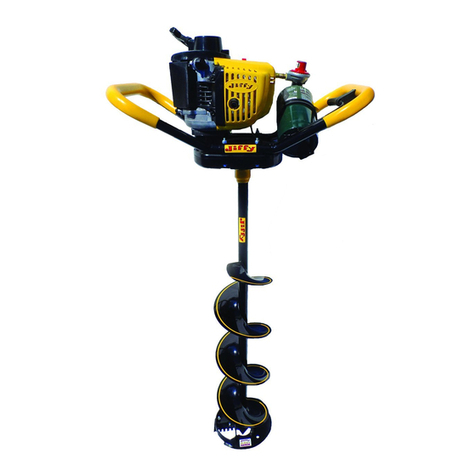
Jiffy
Jiffy PRO 4 Operating manual/parts guide
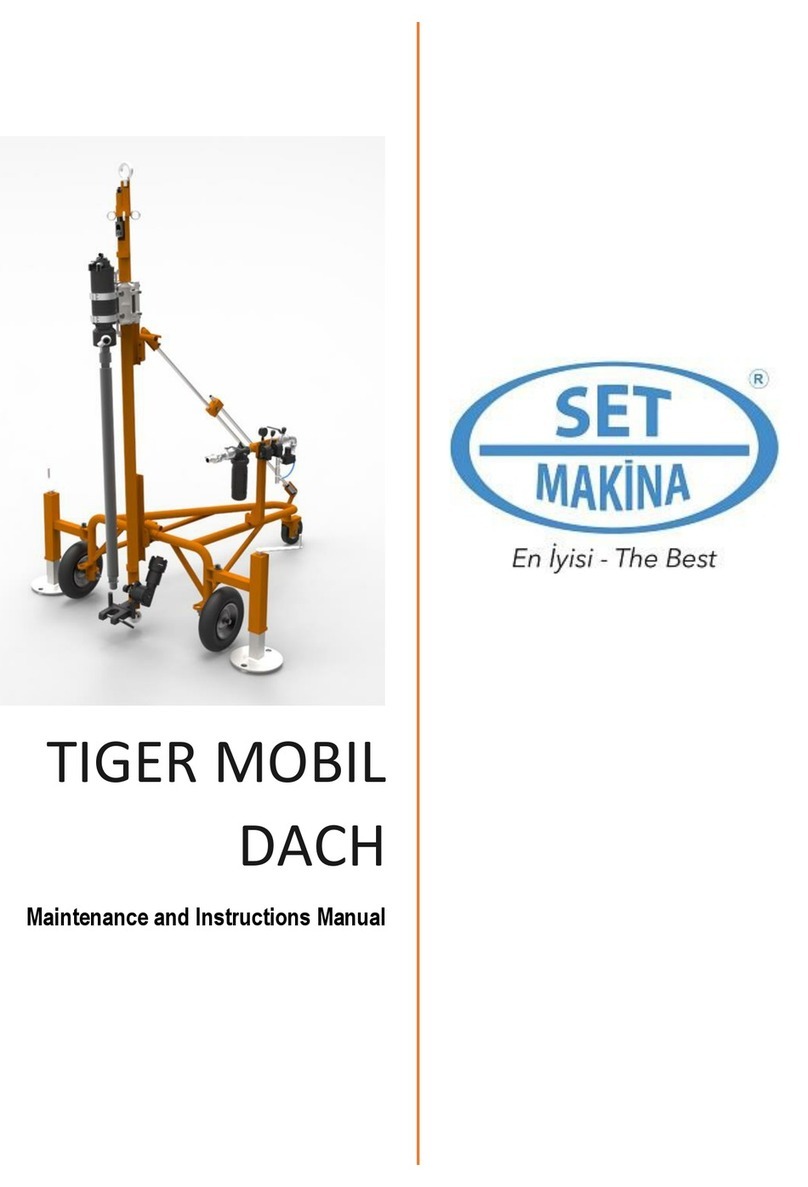
SET-A Makina
SET-A Makina TIGER MOBIL DACH Maintenance and Instruction Manual
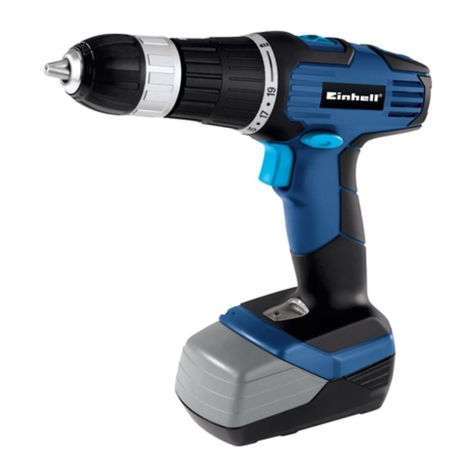
EINHELL
EINHELL BT-CD 18/1 i Original operating instructions
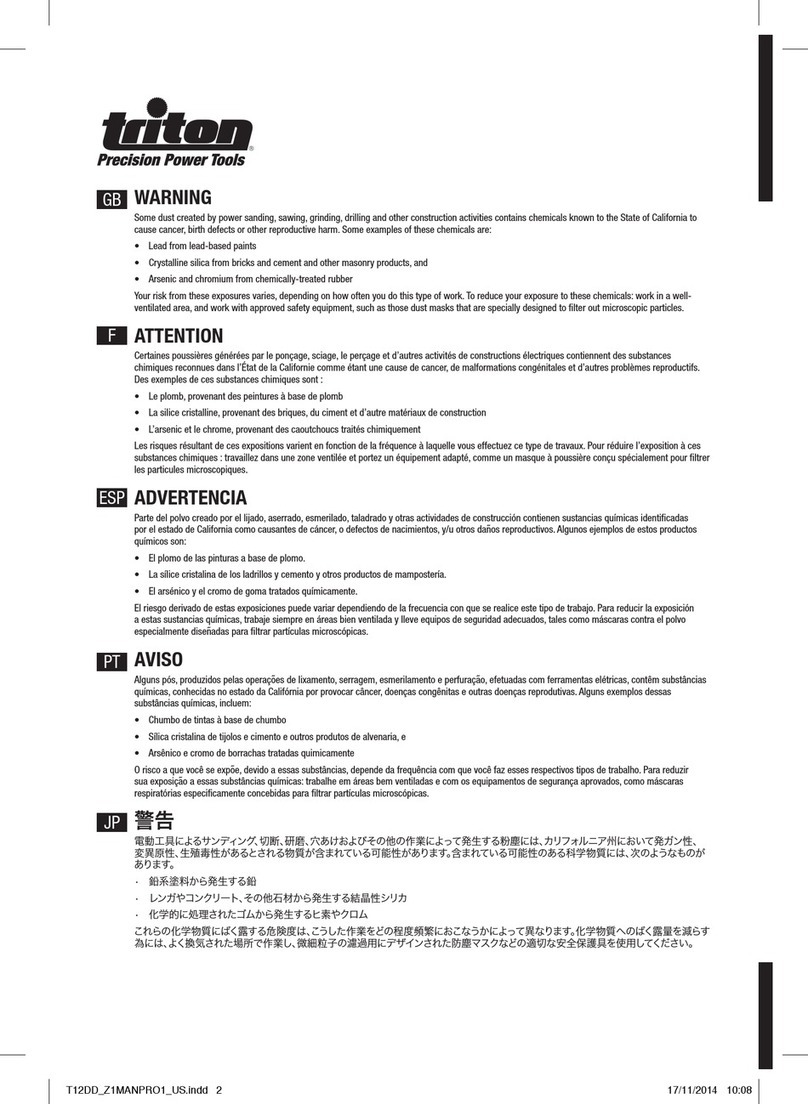
Triton
Triton T12DD Operating and safety instructions

Makita
Makita 6407 instruction manual
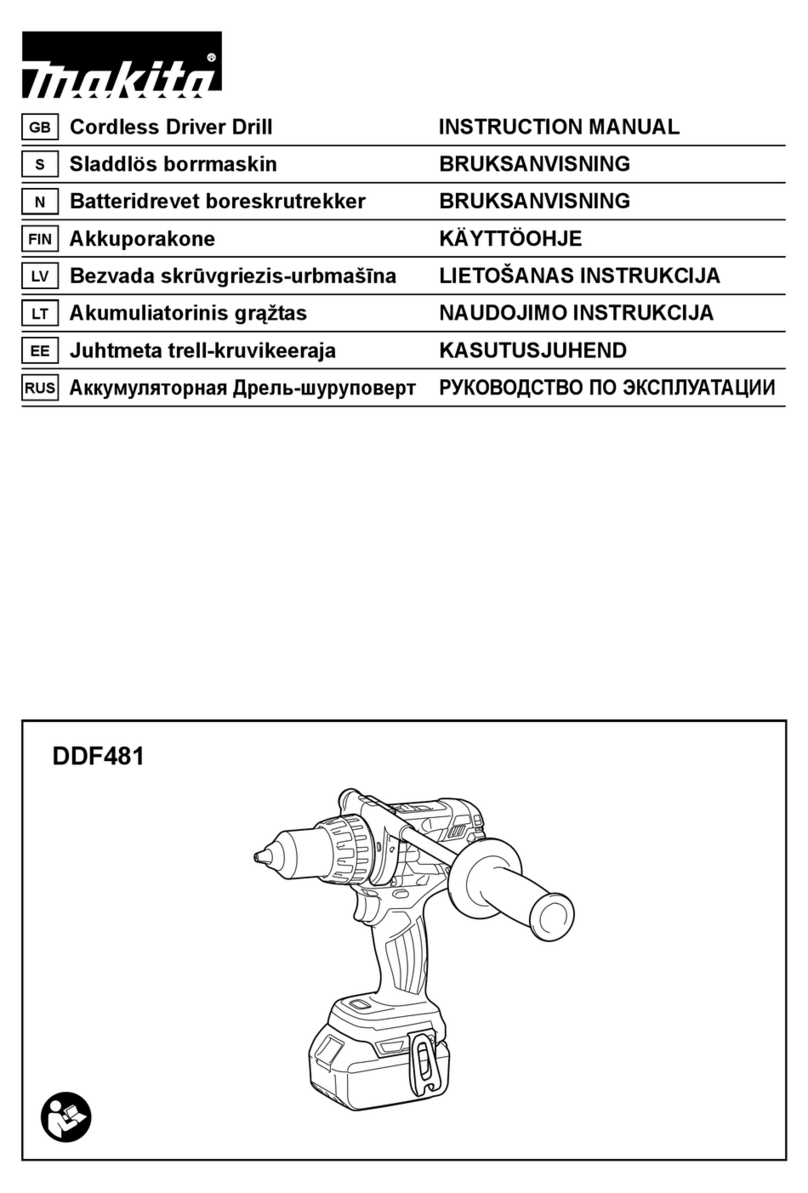
Makita
Makita DDF481 instruction manual

